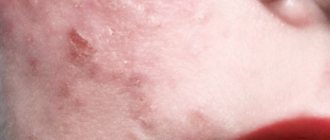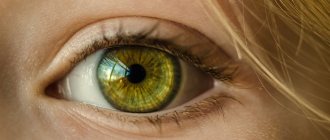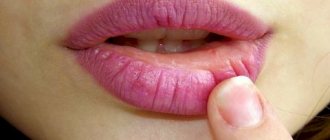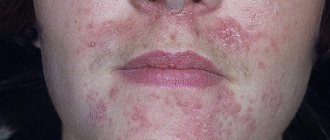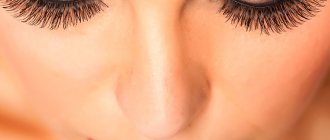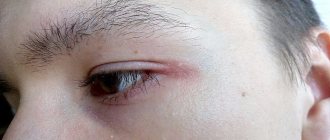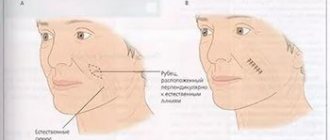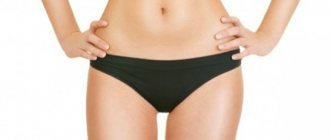One of the most common problems related to both cosmetology and medicine is peeling skin on the nose.
Characteristic symptoms are:
- Skin hyperemia.
- Itching around the nose.
- Feeling of skin tightness and soreness.
Sometimes it’s enough just to properly care for your skin and properly protect it from drying out. If the problem remains a problem and peeling of the skin on and around the nose continues, you will need to consult a qualified specialist - a cosmetologist or dermatologist.
It is a mistake to think that peeling skin near the nose is the prerogative of those with dry skin. The skin begins to peel off due to the accelerated death of the epidermis, and the disease can be provoked by many reasons, including: vitamin deficiency, runny nose, allergies. The most unpleasant thing is that areas of flaky skin are difficult to hide even with the help of cosmetics and foundations, since they only highlight the existing problem.
Why does the skin on my nose peel?
There are two types of causes of skin peeling: physiological and pathological. Among the most common are:
- Avitaminosis. A lack of vitamins D, C, A, PP, E, K, B can provoke peeling of the skin.
- Allergy to low-quality cosmetics. It is observed in people with sensitive skin types.
- Respiratory diseases. Due to a runny nose, a person is forced to frequently touch the nose area with a napkin or handkerchief, which can cause the skin to dry out. Also, the components of the drops can cause irritation.
- Environmental influence. Abnormal air temperatures, high or low, affect the condition of the skin.
- Incorrect facial care. Using products that do not match your skin type can cause dryness of the upper layer of the epithelium.
- Hormonal changes. Increased levels of the stress hormone (cortisol) lead to peeling of the facial skin.
- Salon procedures. Techniques such as ultrasonic, mechanical or combined facial cleansing cause peeling of the skin for 5 days.
The skin on the nose can peel off for pathological reasons:
- Fungus (candidiasis, rubromycosis, pityriasis versicolor, microsporia, trichophytosis, seborrheic dermatitis). The latter is caused by the yeast-like fungus Malassezia, the causative agents of the others are Trichophyton, Microsporum, Candida.
- Dermatitis of another etiology (perioral). It occurs due to long-term use of corticosteroids.
- Acne (blackheads). This inflammatory skin condition causes excess sebum production, causing clogged pores and resulting in flaking of cells.
- Systemic lupus erythematosus. The human body begins to fight with its own cells. The disease occurs due to genetic characteristics and hormonal changes.
- Lupus pernio (lupus pernio). Accompanied by staining of the skin of the nose. Its exact causes are unknown, but genetic predisposition may play a role.
- Psoriasis. The disease occurs as a result of an immune response, and peeling occurs due to the accelerated rate of cell division.
- Periarteritis nodosa. It is a form of vasculitis affecting small arteries; the exact causes of its occurrence are unknown.
Depending on symptoms
When diagnosing the condition, the dermatologist pays attention to the accompanying symptoms. Along with peeling, the following may appear:
- red spots, itching, ulcers - demodicosis;
- irritation - seborrheic dermatitis;
- redness - hyperemia of the skin;
- itching, tightness, red spots similar to pimples - fungal infection;
- pain, cracks - eczema;
- rash, tingling, dry skin - allergies.
Depending on location
The area of peeling can tell more about why this skin defect appears. Depending on the local location of the deficiency, the following causes of its occurrence are distinguished:
- around the nose and mouth - vitamin B deficiency;
- on the forehead and around the nose - dermatitis;
- scalp, forehead and nose - inflammation in the lower layer of the epidermis;
- on the chin and nose - diseases of the digestive system;
- under the nose, on the wings of the nose and around the nostrils - previous acute respiratory infections, the use of sprays and drops for a runny nose;
- on the sides - rosacea (a skin condition accompanied by superficial dilatation of blood vessels, swelling, papules, pustules);
- bridge of the nose - allergic reaction.
Symptoms of rosacea
The clinical manifestations of the disease differ depending on its form. But in most cases, rosacea is accompanied by the following symptoms:
- Erythema. Redness of the skin in the central part of the face. Initially, it is episodic in nature, but over time the frequency of occurrence increases. The shade can vary from bright pink to bluish.
- Increased dryness of the skin, excessive sensitivity to touch. In some cases, mild pain or a tingling sensation may occur.
- Telangiectasia. The so-called spider veins. They are dilated capillary vessels that look like small spots and nets of pink or red color. Most often located around the wings of the nose.
- Papules. Dense skin nodules that rise slightly above the surrounding skin. The color is flesh or pale pink. When there are large numbers, they can merge into one common bumpy surface.
- Pustules. Small bubbles filled with clear or slightly cloudy liquid. Formed in place of papules.
- Structural changes in the skin. Initially, swelling of the affected areas occurs, which can subsequently be combined with hyperplasia (thickening) of the skin. In some cases, large structural formations form that distort facial features.
- Eye lesions. Redness of the mucous membranes, often combined with itching and a feeling of “sand” in the eyes. In severe cases, crusts appear at the roots of the eyelashes, and visual acuity decreases.
Erythema with rosacea.
Photo: Head & face medicine / Open-i (CC BY 2.0) Rosacea is characterized by periods of exacerbations and remissions. During exacerbations, new elements of the rash (papules, pustules) appear. When going into remission, the rash often disappears, but skin erythema, telangiectasia and structural changes in the facial skin persist.
Causes of dermatological disease
In order to successfully treat any pathological condition of the epidermis, it is necessary to establish the cause of the disease. Irritation and peeling of the skin of the nasolabial area and the triangle area can be caused by the presence of the following negative factors, namely:
Allergic reaction. The left and right wings of the nose are covered with very sensitive skin, which reacts aggressively to low-quality cosmetics, some types of food, temperature changes, when a person accustomed to warmth is in the cold for too long
Much attention should be paid to the choice of soap for washing. Don’t chase expensive brands, pleasant color and smell of hygiene products
It is better to give preference to hypoallergenic baby soap. Infectious inflammation. Near the nasal sinuses there are several sebaceous glands that protect the skin of the respiratory organ from the environmental atmosphere by producing oil. When the glands function too intensively, excess sebum accumulates on the epidermis and open pores become clogged. If harmful bacteria enter them, inflammation of the epithelium begins, affecting the upper layer of the circumference of the nose. Avitaminosis. Human skin is one of the largest external organs, which has a complex multi-level structure with its partially autonomous organization of work. This functionality requires a stable supply of sufficient nutrients. A deficiency of vitamins and minerals can negatively affect the skin around the nose. Especially often, manifestations of vitamin deficiency in this part of the face are observed in people suffering from chronic rhinitis or inflammatory processes in the paranasal sinuses. Fungus. On the sides around the nose there are small corners where the organ of smell comes into contact with the cheeks. Fungal microorganisms like to form their colonies in such small folds. As their number increases, they can affect a larger area of the skin of the face, forming a spot around the nose that is characteristically red, dry, and may peel. If there is a fungus around the nose, the patient always experiences a strong feeling of itching, which intensifies as the fingers touch it.
Demodecosis. This dermatological disease does not occur often, as it can only occur in people with a weakened immune system. Demodicosis is caused by subcutaneous parasitic Demodex mites. It is believed that these microorganisms are present in 97% of the inhabitants of planet Earth, but they manifest themselves only in cases where the human body is severely weakened, is in a difficult emotional state, has experienced a large amount of nervous stress, or is physically exhausted. Demodectic mange is also common in pregnant women and women who have hormonal diseases. In terms of its symptoms, the disease is very similar to a fungal infection, so without special medical equipment it is almost impossible to diagnose the presence of subcutaneous parasites around the nose.
Each of the listed causes of the pathological condition of the epidermal tissues around the nose must be treated in the early stages of development in order to prevent the occurrence of complications, damage to large areas of the skin and the transition of the disease to the chronic stage
The greatest attention should be paid to eliminating fungal infections and parasitic life forms. Both of them have a natural ability to spread not only around the primary lesion, but also deep into the soft tissues down to the bone base of the body
Answers on questions
Can oil-based vitamins be used to treat flaking?
Oil-based vitamins A and E have a good effect on the skin. However, you cannot apply them yourself to the affected area. Add vitamins to masks or peeling products.
Can autoimmune diseases cause redness?
Autoimmune diseases can cause redness of the skin under the nose, as well as on the cheeks. One of these pathologies is lupus. Another common autoimmune disease is psoriasis. To treat these diseases, immunostimulants are used, which can only be prescribed by a doctor after diagnosis and laboratory tests.
Can diabetes cause peeling?
Peeling skin is often present in diabetes, but is not a mandatory symptom. To confirm the diagnosis, you need to donate blood for sugar. However, along with elevated sugar levels, there may be other causes of peeling, so do not rush to conclusions. Only a doctor can prescribe the final diagnosis and treatment.
Causes of peeling skin in the nose area
Dermatological specialists identify a number of reasons that cause this unpleasant symptom.
Allergy
Very often, redness of the skin is caused by an allergic reaction of the body. Typically, this causes itching, the skin begins to peel, and you begin to sneeze. The reason for this may be food or certain components of cosmetics. To overcome allergies, you will need to undergo a course of treatment, which should be prescribed by an experienced allergist. He will determine what exactly causes this reaction in the body and prescribe proper treatment. On your part, you need to exclude from your diet fatty, spicy, heavily fried and smoked foods, as well as semi-finished and instant foods. Try to eat only healthy foods and drink clean, non-carbonated water.
Avitaminosis
If the skin peels not only around the nose, but throughout the body, then this may be caused by vitamin deficiency. As a rule, it occurs in the spring, when the body is weakened and has a lower threshold of resistance to negative environmental factors. The body exhibits a sharp deficiency of vitamins and essential minerals. This problem can arise due to unfavorable environmental conditions, smoking, drinking alcohol and leading a sedentary lifestyle. The body becomes weak and susceptible to all sorts of diseases. The lack of vitamins A and C leads to the fact that the skin becomes fragile, and a low intake of vitamin E worsens the water balance, which leads to dry skin.
How to treat a weakened body? Regular intake of a vitamin complex can improve this condition. Experts also recommend increasing the amount of consumption of the following products in your diet:
- fatty fish;
- liver;
- boiled meat;
- butter;
- chicken egg yolks;
- greenery;
- fresh fruits and vegetables
To treat vitamin deficiency, you should give up bad habits, lead an active lifestyle, take daily walks and drink 2 liters of water a day. From late autumn to spring, you can drink a rosehip decoction, which will saturate the body with vitamins.
Runny nose
If the wings of your nose are peeling, this may be the cause of a lingering runny nose. Accumulating mucus creates irritation of the epidermis, and since you try to constantly remove it, redness and micro-wounds appear.
Failure to comply with basic care
If the skin around your nose, cheeks and forehead, as well as around your mouth peels, this may indicate that you are using the wrong soap, milk, face cream, gel or foam. This may be caused by the body's reaction to components of cosmetic products that do not moisturize the skin, but rather dry it out. Therefore, it is recommended to use cosmetics from trusted companies. They should contain the necessary fats and vegetable oils that moisturize the skin and nourish it with minerals and trace elements. It is best to entrust the selection of cosmetic products to a specialist - a dermatologist or cosmetologist.
External factors
Very low or high temperatures can also affect the overall health of the skin. If the skin on the bridge of the nose and around the nose is peeling, this may be caused by exposure to very low temperatures. If it is severely frosty outside, it is recommended to lubricate your skin with protective cream before going out. It must be selected according to your skin type. At least 20 minutes before going out, apply it to the skin and let it absorb. Chlorinated water can also cause skin irritation, so it is better to wash your face with clean well or settled water.
Skin disease
If you notice red spots, the skin begins to itch and peel, this may be caused by a skin disease. In this case, you need to visit a good dermatologist. After the test and examination, the doctor will prescribe the correct treatment. The nose and area around it may also peel from infection with skin parasites or when a fungal disease develops. It could be:
- seborrheic dermatitis;
- seborrheic psoriasis;
- eczema.
These serious diseases can be caused by increased oiliness of the skin, unbalanced and unhealthy diet, stress, hormonal imbalance and nervous strain.
What to do to prevent skin from peeling
Peeling can be eliminated with comprehensive preventive measures. Be sure to review your diet and include dishes rich in B vitamins, tocopherol and retinol. Eat more:
- fresh carrots;
- green vegetables;
- sea fish;
- dairy products;
- nuts;
- whole grain porridge.
Advice. Avoid eating citrus fruits, chocolate, smoked meats and pickles. They are a common cause of allergic reactions that appear on the nose.
Drink at least 2 liters of clean water daily to prevent lack of moisture in your cells. During the off-season, take vitamin complexes to increase the body's defenses.
A red, scaly nose does not tolerate hot or ice water. To wash your face, use mineral water at room temperature. Avoid alkaline soap. Cleanse with cosmetic milk or oatmeal.
- Grind the flakes with a coffee grinder and place in a plastic container.
- Before washing, pour a little powder into your palm and dilute with warm water until it becomes sour cream. Apply to face, massage the sides of the nose and rinse.
- Do not rub your skin with a towel. Gently blot the moisture with a napkin, wipe the dermis with tonic and apply moisturizer.
Do not use alcohol-based products for daily care. They dry out and increase flaking. When going outside in the summer, protect your face from ultraviolet radiation with special means. In winter, use a thick foundation that protects from frost and wind.
If the area around your nose is covered with white scales, under which red spots have formed, do not rush to clean them with your fingers. First, soak the peeling with water and lubricate with Vaseline. Take a piece of gauze, folded several times, and rub the affected areas, removing the scales. After completing the manipulation, rinse the epidermis with chamomile infusion, dry and lubricate with cream.
Rosacea
Rosacea is a chronic skin condition that can cause redness, redness, and visible blood vessels. It is not uncommon, but there is currently no cure for it.
Erythematotelangiectatic (ETH) rosacea and rosacea are subtypes of the condition that can cause rashes and redness around the nose.
How to treat redness
Redness from rosacea is treated differently than redness caused by other conditions.
Avoid the ingredients witch hazel and menthol, which are found in many toners and other exfoliating products.
Prescription topical ointments can be used to treat redness. Laser treatment is also an excellent treatment option for persistent facial redness due to rosacea.
Lifestyle recommendations
People with rosacea usually need to figure out what's causing their symptoms to reduce the frequency of flare-ups.
Common triggers include spicy foods, alcoholic drinks, and prolonged sun exposure.
People with rosacea should also wear a high SPF sunscreen or a physical blocker such as zinc oxide, as well as sun-protective clothing.
Complications of rosacea
Rosacea can lead to various complications, both infectious and cosmetic. The most common are:
- Purulent-septic complications. This includes all types of skin lesions associated with secondary infection, most often with pathogenic bacteria. One of these is the draining sinus. It is a long-term, sluggish inflammation, accompanied by the formation of an oval skin formation, from which purulent masses are constantly released.
- Eye lesions. Long-lasting inflammatory reactions of the tissues of the eye and eyelid against the background of ophthalmic rosacea can lead to deterioration of vision. In severe cases, even its complete loss - blindness - is possible.
- Gross cosmetic defects. Long-term course of rosacea, especially with its phymatous and granulomatous variants, often leads to deformation of parts of the face (nose, ears, chin). This significantly reduces a person’s quality of life and can also become a trigger for depressive disorders.
Coffee can worsen rosacea symptoms. Photo: valeria_aksakova / freepik.com
Treatment methods
Etiotropic therapy consists of treating the root cause. Treatment of symptoms is necessary to reduce or remove severe symptoms not associated with internal disorders. Treatment tactics involve the use of not only medications, but also physiotherapeutic and caring procedures that protect the skin from external factors.
Redness on the face can be removed using the following products:
- keratolytic, which gently cleanse the skin, remove scales, and prevent further clogging of pores;
- anti-inflammatory, reducing existing inflammation;
- antibacterial;
- adsorbents.
Before using the products suggested in the table, you should consult a dermatologist. Resolving skin redness depends on the underlying cause, which needs to be determined.
| Effect of the drug | Name | Price in rub. |
| Anti-inflammatory | Advantan | 500 |
| Afloderm | 230 | |
| Elokom | 100 | |
| Keratolytic | Roaccutane | 1600 |
| Differin | 700 | |
| Belosalik | 200 | |
| Baziron | 600 | |
| Lorinden | 350 | |
| Antibacterial | Skinoren | 600 |
| Belogent | 130 | |
| Hyposol | 1100 | |
| Tea tree oil | 100 | |
| Absorbents | White clay | 30 |
The products used should not contain alcohol, so as not to dry and irritate the skin. It is better to select tonics based on juniper, chestnut, and hops.
Useful vitamins for facial skin:
- Vitamin D increases protective properties and regenerates the skin.
- Vitamin K, anticoagulant, helps with vascular defects, brightens the skin.
- Vitamin E, an antioxidant, restores damaged cell membranes.
- Vitamin A accelerates healing, supports collagen synthesis, and has a positive effect on the immune system.
- Vitamin C strengthens capillary walls and slows down skin aging.
When treating rosacea, heparin ointment helps well; the course of treatment should not exceed 1 week. Oxymetazoline cream and laser treatment help with rosacea.
Traditional methods
Products based on:
- witch hazel;
- mint;
- eucalyptus;
- carnations.
You can use masks based on green tea, turmeric, cucumber, and ginger.
Aloe pulp is good for soothing irritated skin:
- Remove the pulp from the core of the leaf and apply to your face.
- Perform the procedure 2 times a day
Mask based on coconut oil, a natural emollient product that retains moisture in the skin:
- Soak a swab in oil and wipe your face.
- Leave until dry, then rinse with warm water.
Oatmeal mask:
- Grind pure oats to flour, mix with milk or water.
- After the oats have absorbed all the liquid, apply the mixture to your face.
- The procedure can be carried out every day, applying the mask for 20 minutes.
Cucumber mask:
- Fresh cucumber, peeled, cut into discs.
- While lying down, place cucumber slices on your face. Keep for at least 20-25 minutes.
- It is not recommended to rub the pulp into the skin so as not to cause irritation.
Green tea lotion:
- Brew green tea. Let it brew.
- After brewing, while the drink is still warm, pour the tea into a wide bowl and soak a cotton napkin in it.
- After wrung out the fabric, apply it to your face and leave for 10-15 minutes.
- You should not actively rub tea into the skin so as not to irritate it.
Other methods
Redness on the face can be removed with peeling. For irritated skin, it should be gentle, properly regulating the exfoliation of the surface layer.
- Glycolic peeling. The glycolic acid molecule is very small, so it quickly penetrates the epidermis without causing irritation.
- Lactic. Lactic acid whitens the skin, brightens and strengthens the walls of blood vessels.
- Peeling with retinolic acid. This is the most superficial, gentle peeling that is gentle on the skin.
To strengthen blood vessels, we can recommend PQ Age peeling based on trichloroacetic acid. After it, a whitening, rejuvenating effect is created with minimal exfoliation.
Electroporation sessions with glycolic acid will help restore the functioning of capillaries and epidermal cells.
For hormonal disorders that occur during menopause, you should strengthen the immune system, do yoga, exercise, and massage. To strengthen the nervous system, take antidepressants: Paroxetine, Venlafaxine. The proposed techniques will reduce the wave of “hot flashes” that affect the redness of the face.
Causes and treatment
Redness or peeling under the nose is often perceived as a cosmetic defect that has nothing to do with illness. However, medical practice shows that skin changes occur under the influence of two groups of factors:
- environmental exposure;
- pathological changes in the body.
The first group is associated with negative weather or temperature conditions that provoke peeling and redness (burns, frostbite, chapping, etc.), mechanical effects on the skin. Treatment consists of selecting medications to protect the skin from aggressive external factors and heal wounds and microcracks.
The second group is associated with painful changes in the body, and peeling of the skin under the nose is only one of the symptoms of pathology. Treatment consists not only of healing and softening the skin, but also of eliminating the internal disease.
Drugs for the treatment of redness under the nose are selected only by a doctor based on an external examination and laboratory tests.
Dermatovenerologist Irina Igorevna Lazuk will talk about the causes of peeling of the facial skin under the nose and in the mouth area. After watching the video, you will understand when you should see a doctor and when you can get by with moisturizers at home.
Environment
The easiest way to cure redness under the nose is if it was the result of a burn or frostbite. To heal the skin, dermatologists recommend ointments:
- "Panthenol" (analogue of "Pantestin"). This is an effective dexpanthenol-based product that quickly heals wounds and microcracks. Dexpanthenol penetrates cells and turns into pantothenic acid, which accelerates tissue regeneration. To get rid of flaking, lubricate the skin under your nose up to 3 times a day.
- "Aekol" . A medicine based on an oil solution of vitamins A, K, E. It stimulates skin regeneration, acts as an antioxidant, and relieves inflammation. To treat redness, apply the ointment to a piece of gauze and apply to the affected area. Repeat the procedure 2-3 times a day until the skin heals.
- "Algofin" . A medicine based on chlorophyll-carotene paste. It destroys pathogenic bacteria, relieves inflammation and promotes healing. To get rid of peeling, lubricate the skin 2-3 times a day for a week.
- "Wundehil" . An ointment with a natural composition, which includes propolis, sophora, yarrow and other ingredients. "Wundehil" heals wounds well and accelerates regeneration. To get rid of inflammation, lubricate the skin 2-3 times a day for a week.
- "Methyluracil" . A healing medicine with the same active ingredient. It enhances regeneration and relieves inflammation well. Continue treatment for 2-3 weeks, applying the ointment to the skin under the nose 1-2 times a day.
- Sudocrem and zinc-based preparations. Zinc ointment, Sudocrem and its direct analogues, which contain zinc (for example, Bübchen cream), can relieve inflammation and improve skin condition within 1-2 days. Zinc promotes healing and protects the skin from external negative influences. 1 week is enough for a course of therapy. During this period, apply the ointment 1-2 times a day to the affected area.
Before choosing an ointment, consult your doctor. Some components of the medication may cause an allergic reaction.
Mechanical effect on the skin
Redness and peeling of the skin under the nose also occur due to mechanical effects:
- squeezing out blackheads or pimples;
- piercing;
- frequent use of breathing masks at risk of developing apnea and asthma.
This skin irritation does not require special treatment. Wound healing creams (Pantestin, Sudocrem) and eliminating the main cause of skin damage are enough.
Rosacea
One of the causes of redness under the nose is rosacea. This is the name of a disease characterized by persistent redness of the facial skin with the formation of papules, swelling, and pustules.
In addition to redness near the nose, other symptoms indicate rosacea:
- oily skin on the forehead;
- formation of red acne on the face;
- itching, dry eyes;
- periodic feeling of a rush of blood to the skin of the face.
Treatment of rosacea is complex and includes a number of measures:
- giving up bad habits (smoking, alcohol);
- diet excluding salty and spicy foods;
- taking antibiotics to eliminate pathological microflora (Tetracycline, Doxycycline, Minocycline) and the antiparasitic drug Metronidazole;
- local treatment with Skinoren gel or Ovante cream with crystalline sulfur to eliminate inflammation and swelling;
- the use of ointments with metronidazole “Metrogil”, “Rozamet”;
- taking vitamin preparations to strengthen the walls of blood vessels (“Ascorutin”, “Antistax”);
- use of antihistamines (Cetrin, Suprastin);
- physical therapy to smooth out the skin (dry ice treatment, liquid nitrogen therapy).
Rosacea is not a dangerous disease, but it causes a lot of discomfort and requires long-term treatment.
Dermatitis
The cause of redness can be 2 types of dermatitis:
- perioral;
- seborrheic.
Perioral dermatitis occurs as a result of rosacea, infectious skin lesions, as well as the use of certain toothpastes, hormonal creams and cosmetics. The disease is characterized by redness of the skin, itching and peeling.
Seborrheic dermatitis most often occurs on the scalp, but can also affect areas of the skin on the face. The disease is characterized by peeling of the skin, while the feeling of excessive sebum secretion persists.
Treatment for dermatitis depends on its type. For oral disease, it is sufficient to use healing preparations based on zinc (Sudocrem, zinc ointment). If a bacterial infection occurs, antibiotics are prescribed, for example, Tetracycline. You should also stop using nasal sprays and hormonal ointments.
Seborrheic dermatitis is fungal in nature, therefore it is treated with antimycotic tablets “Orungal”, “Nizoral” and others. They effectively destroy mold and yeast. For external use, antifungal ointments “Keto Plus”, “Zalain” and others are recommended.
Allergy
An allergic reaction often causes irritation and peeling of the skin under the nose. An allergy can be triggered by any substance in the external environment, food, dust, etc.
Before prescribing anti-allergy medications, conduct a laboratory test for allergens. Treatment involves:
- eliminating contact with the cause of the disease;
- taking antihistamine tablets “Suprastin”, “Cetrin”, “Clemastin”;
- applying antihistamine ointments and gels “Fenistil”, “Skin-cap”, “Prednisolone”, “Advantan” and others to the affected skin.
ARVI and acute respiratory infections
Respiratory viral diseases most often cause a runny nose, which results in irritation of the skin under the nose. To treat skin lesions, only wound-healing creams and ointments are not enough: the cause must be eliminated.
For the treatment of ARVI, antiviral drugs “Cycloferon”, “Anaferon”, “Kagocel” and others are prescribed. To rinse your nose, use nasal sprays “Aqualor”, “Dolphin”, “Aquamaris”.
To remove nasal discharge, do not use wet alcohol wipes or rough cloths. They quickly irritate the skin when rubbed and dry it out, causing redness and flaking. It is best to blow your nose under running tap water: the impact on the skin under the nose will be minimal.
Demodicosis
This is what is called skin damage by subcutaneous mites. The main symptoms of the disease are itching, peeling, and redness of the skin due to the movement of microorganisms under the skin.
To diagnose the disease, laboratory testing of skin scrapings and samples is used. If the diagnosis is confirmed, the doctor prescribes drugs based on tinidazole and metronidazole (Permethrin, Metronidazole, Metrogyl). They destroy mites, create a cooling effect and restore the skin.
Methods for getting rid of flaking skin on the nose
If the skin under your nose is peeling, there is no need to let the situation take its course. Firstly, this is an ugly phenomenon, and secondly, be sure to understand the reasons for its occurrence. Without doing this, you will only be able to get rid of the anomaly for a short period of time, but the main problem will still remain.
So, what to do if your nose is peeling? To do this, follow simple rules for the safe removal of dead skin.
- Never scrape dead skin cells dry to avoid infection. Before this procedure, the epidermis should be well moistened with water and then with a rich cream. Only after this, using a soft cloth or cotton pad, can you begin manipulation.
- After the skin that peels off on the wings of the nose or around it is removed, you need to wipe your face with an antiseptic (you can use a decoction of chamomile or calendula for this), and then apply a moisturizer to it. It is better to choose a product that is based on natural ingredients (extracts of medicinal herbs, healthy fruits, flowers, etc.).
Now we should consider in more detail the question of what to do if the skin on the nose often peels off. Removing it using the above-described manipulations every time is not the best option. It's easier to prevent it from starting to peel off.
- Use only high-quality cosmetics that fully match your facial skin type. Avoid using antibacterial soap, which dries and depletes the epidermis.
- Get examined by a doctor in a timely manner for dermatological and endocrine diseases. Heal them completely to avoid serious consequences, including for facial skin.
- Wash with soft water. If tap water is too hard, use filters to settle it. This will help avoid irritation of the epidermis, leading to peeling of the skin on the nose.
- Drink enough fluids. It is necessary not only for the normal functioning of the kidneys, but also for moisturizing the epidermis.
- Avoid sudden changes in temperature.
- During the hot season, always apply a protective cream to your facial skin to prevent it from getting “burned” and starting to peel off.
If the skin near the nose and eyebrows is peeling, you can try applying masks made from natural ingredients to these areas of the face. Several such recipes are presented below.
https://youtube.com/watch?v=dAby5kNHdt4
Curd and oil mask
If the skin on the bridge of the nose, wings of the nose or around it is peeling, this cosmetic product will cope with the problem perfectly. To prepare it, you need to take 5 g of low-fat cottage cheese (it is better if it is homemade), as well as 1 teaspoon of olive oil and fresh, finely chopped parsley. Mix the components and distribute evenly over the epidermis of the nose, as well as onto the areas around it.
After a quarter of an hour, carefully wipe the mask with a soft cloth or cotton pad soaked in a decoction of chamomile or calendula.
Mask with linden decoction (infusion)
Mix linden decoction or infusion, oatmeal and olive oil in equal proportions. Mix until smooth and apply to problem areas of the nose. The mask can also be used to get rid of roughness of the epidermis and its cracking on other parts of the face.
Leave the product on for 7-13 minutes, then remove lightly with warm water.
In order not to think about the question of what to do if the skin on your nose is peeling, you can make the first and second mask (alternately) for prevention. At the same time, it is better to apply them not only to a specific area of the skin, but also throughout the entire face. Since such cosmetics are prepared exclusively from natural ingredients, they cannot cause harm to the skin.
Recommendations from cosmetologists
Experts advise getting tested and, if peeling is a consequence of pathological processes in the body, undergoing appropriate therapy. To exclude a fungal infection, a scraping is taken from the reddened area. The doctor examines the scales and determines the presence of pathogenic flora.
Cosmetologists recommend a combination treatment, including:
- proper nutrition;
- salon treatments;
- medicinal ointments and creams;
- traditional methods.
Flaky skin near the nose ceases to bother you after a course of moisturizing professional masks. The doctor selects ingredients that match the type of epidermis. Good results are provided by collagen, hyaluronic acid, emollient oils, herbs, and seaweed.
Mesotherapy eliminates red spots and peeling on the nose. The procedure involves the injection of various drugs under the skin. To treat acne and relieve inflammation, absorbent and antibacterial agents are used, and moisturizing components are used to soften.
This is interesting! Biorevitalization helps against severe dehydration. During the session, hyaluronic acid is injected into the deep layers of the skin. The procedure triggers cell regeneration, restores metabolic processes, and eliminates dryness and sagging.
When the wings of the nose peel off, cosmetologists offer salon peeling, hardware massage, and paraffin therapy. One of these procedures is shown in the video:
Causes of red, scaly spots
Response to environmental factors. This problem often occurs among those with dry skin: with prolonged exposure to cold, strong wind, or exposure to the sun, the face begins to peel and become covered with spots.
Avitaminosis. If there is a lack of certain vitamins in the body (A, C, P), the skin becomes dry, irritated, and spots often appear on it. Usually in this case, red spots appear in the spring.
Demodecosis. This is a disease caused by a subcutaneous mite.
Rosacea. This is an inflammatory skin disease (chronic), which causes red spots and purple pimples to appear on the face. They abundantly cover the cheeks, chin and nose. The cause of rosacea is unknown.
Acne. When acne (blackheads) appears, red spots appear on the face with a raised area in their center. Most often, acne occurs during hormonal disorders, including adolescence, menopause, and pregnancy.
Nerve spots. In some people, when they are very nervous, their face, neck, and upper chest become covered with red spots.
Helminthiasis. Redness on the face also occurs due to the presence of parasites in the body.
Diagnosis of rosacea
Diagnosis is based on the patient’s complaints, medical history (course of the disease, provoking factors, concomitant pathologies, presence of risk factors) and physical examination. Laboratory and instrumental research methods can be used as auxiliary means.
In most cases, the diagnosis is established after examining the skin by a dermatologist, including using dermatoscopy. A distinctive feature of rosacea is persistent redness of the central area of the face with intact areas around the eyes, which persists for at least 3 months.
In order to differentiate with other diseases and clarify the existing form of rosacea, the following additional diagnostic methods can be used:
- Microscopic examination of skin scrapings to identify Demodex folliculorum mites.
- Bacteriological examination of the contents of pustules to detect secondary infection.
- Routine blood and urine tests, supplemented by tests for markers of systemic connective tissue diseases.
- Dopplerography. Allows you to study microcirculation in the vessels of the facial skin and identify the slowdown in blood flow characteristic of rosacea.
- Ultrasound examination (ultrasound) of the skin. It is used to determine the structure of skin formations and the thickness of skin layers.
- Confocal laser scanning microscopy. Allows you to assess the condition of the skin down to the reticular layer of the dermis without compromising its integrity. Due to this, you can obtain detailed information about regional vessels, cells of different layers of the skin, as well as study the degree of xerosis (dryness) and peeling, and the number of demodex mites.
Differential diagnosis of rosacea is carried out with other diseases that may have similar symptoms. These include:
- Seborrheic dermatitis.
- Discoid lupus erythematosus.
- Dermatomyositis.
- Randu-Osler syndrome.
- Perioral dermatitis.
- Acne vulgaris.
- Rubromycosis of the facial skin.
- Small nodular form of sarcoidosis.
- Tuberculous lupus.
- Erysipelas.
- Shingles.
- Angiosarcoma.
Allergic contact dermatitis.
Allergic contact dermatitis is caused by direct contact with an allergen. This rash usually causes itching and discomfort.
Scented wipes, fragrances and skin care products are possible triggers for allergic contact dermatitis around the nose.
How to treat redness
Your first step is to gently wash your face with warm water to remove all traces of the allergen. Allergic contact dermatitis can be treated with over-the-counter 1 percent hydrocortisone.
It is important to exercise caution when applying this product as topical steroids, when applied to the face, may contribute to skin conditions such as acne and rashes. Be sure to eliminate the suspected allergen and use hypoallergenic products. This applies to the use of any products used to wash your face
This applies to the use of any products used to wash your face
Be sure to eliminate the suspected allergen and use hypoallergenic products. This applies to the use of any product used to wash your face.
As a drug-free home remedy, soak the affected area with a cool washcloth or apply aloe vera to soothe redness.
Lifestyle recommendations
If you have recurrent contact dermatitis, you may need to determine what is causing it around your nose. Identifying the substance that affects you and avoiding it is the key to preventing it from flaring up again.
Consider whether redness around the nose could be the result of:
- change your makeup routine
- lotion or tonic
- scented wipes
- new washing powder
People can also develop allergies to products that they have used for a long time without any problems.
Folk remedies
The use of folk remedies for peeling skin under the nose is effective at the initial stage of development of the defect, if the cause of its appearance was environmental or mechanical influence.
If we are talking about a disease, folk recipes are used only for healing. The main treatment is to eliminate the cause, namely internal pathology.
Oatmeal mask
Ingredients:
- A glass of colloidal oatmeal.
- Water.
How to prepare: Take 3-4 tsp. oatmeal and mix with the same amount of clean water. Mix until moist and homogeneous.
How to use: Apply the mixture to reddened facial skin and leave for 15-20 minutes. Then rinse with warm water. Repeat treatment 4 times a week.
Result: Oatmeal relieves inflammation and moisturizes the skin. The redness gradually subsides, the peeling disappears.
Flax seed decoction
Ingredients:
- Flax seeds – 2 tbsp. L.
- Water – 2 tbsp.
How to cook: Pour water over the seeds and put on fire. Boil and cook the mixture until it becomes like a paste. Cool and strain.
How to use: Apply the pulp of brewed seeds to the affected area of the skin for 20 minutes, then remove it and wash with warm water. Repeat the mask 4-5 times a week.
Result: Flax seeds act as a scrub on the skin. Peeling and redness go away. The skin area becomes smoother.
Mustard mask
Ingredients:
- Dry mustard – 1 tsp.
- Vegetable oil – 1 tbsp. l.
How to prepare: Mix oil with mustard and add a little boiled water to form a thick, homogeneous mass.
How to use: Apply the mask to the skin for 5 minutes, then wash well. Make a mask 4-5 times a week. Do not keep the mask on your face for longer than the specified time to avoid getting burned.
Result: The product is suitable for dry, very flaky skin. The skin is moisturized, dead epithelium is exfoliated, healing occurs faster.
What to do
- Regularly apply a product with a moisturizing and soothing effect to the skin.
- Start taking vitamins and medications that strengthen the immune system.
- In case of allergies, it is necessary to identify the allergen, try to exclude or minimize contact with it and take antihistamines.
- To get rid of the symptoms of demodicosis, complex treatment is used, including taking vitamins, local treatment with ointments, and diet.
- In some situations, a dermatologist prescribes professional facial cleansing.
- It is advisable to turn to treatment with homeopathic remedies that affect the entire human body, and not just eliminate visible problems.
General recommendations and prevention
To avoid the formation of redness and peeling under the nose and speed up skin healing, doctors recommend the following measures:
- Avoid using low-quality cosmetics that can cause allergies and irritating products (alcohol tinctures, methanol, facial scrubs). If you have skin problems, do not use hormonal ointments and creams without your doctor's knowledge. Progesterone pills for women can worsen the condition of the skin.
- Do not rub the affected area of the skin, do not squeeze out pimples and pustules. Do not pick off flaking skin: to remove dead epithelium, first moisten the affected area with water.
- In cold weather, apply a rich cream or natural fat, such as goose fat, to the skin around the nose. Do not use vegetable oils for these purposes: they greatly dry out the skin and worsen their condition.
- Avoid bad habits such as drinking alcohol or smoking.
- Eat healthy foods, avoiding overly salty and bitter foods.
- In the autumn-spring period, take vitamin complexes (Vitrum, Aevit) to strengthen the immune system and improve skin condition.
- In severe cases, in the absence of contraindications, resort to cosmetic procedures, such as chemical peeling.
What to remember
- If there is peeling under the nose, avoid using any cosmetics or medications that irritate the skin.
- Eliminate contact with potential allergens.
- If you suspect a disease of the internal organs, go to see a doctor and do not take any measures until laboratory tests are performed and a diagnosis is made.
- In cold and dry weather, use rich creams to protect your skin.
- Use folk remedies to moisturize and relieve inflammation.
